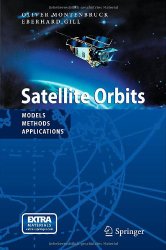Engineering Bookshelf
- Aerospace
- Biological
- Civil
- Chemical
- Environmental
- Electrical
- Materials
- Mechanical
- Petroleum
- Geoengineering
- Software

Satellite Orbits: Models, Methods and Applications
by Oliver Montenbruck, Eberhard GillPublisher: Springer
ISBN: 354067280X
Check price @ amazon.com , amazon.ca , amazon.co.uk
Book Description
This modern presentation guides readers through the theory and practice of satellite orbit prediction and determination. Starting from the basic principles of orbital mechanics, it covers elaborate force models as well as precise methods of satellite tracking. The result is a powerful and unique spaceflight dynamics library, which allows users to easily create software extensions. An extensive collection of frequently updated Internet resources is provided through WWW hyperlinks.
Book Reviews
"Not many books on the topic of satellite orbits over the past decades have been informative, comprehensive and practical. I am happy to say that this publication does fall into that category. [...] This book should certainly be in the library of students and scientists working in the fields of navigation, geodesy, and spaceflight technology, as well as satellite engineers and operators focusing on spaceflight dynamics." - (The Observatory, 2001)
"Satellite Orbits: Models, Methods, and Application would be a valuable addition to the library of any engineer or scientist interested in the practical aspects of orbit prediction and determination. [...] " - (Applied Mechanics Reviews, 2002)
Customer Reviews
By B. Morris
I am just a programmer. I use some of the older, classic literature to write algorithms to track low-earth satellites. I'm not a math major. This book is an excellent addition because it helps me to understand how to connect orbital concepts with the math. It is short and to the point. The book's construction quality is excellent!
By Remco Kroes
This book gives a very good overview of numerical orbit determination methods. I would recommend it to anyone who has the basic knowledge of astrodynamics and is interested in orbit determination. It deals with different force models, numerical integration methods, time and reference systems and filter methods. Every chapter has exercises at its end. These exercises are extremely helpfull for understanding the theory of this chapter. The CD-ROM accompanying the book is absolutely great. It contains all source code (C++) for the different exercises in the book.